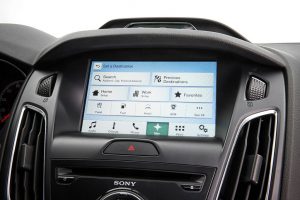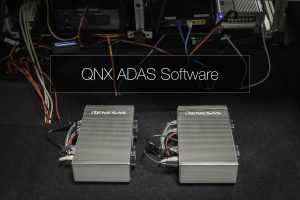
BlackBerry QNX embeds itself in the auto world
Stephen Law
Electronics Embedded Systems Engineering Software Engineering automotive automotive embedded Embedded software software systems systemsFirm’s real-time safe and secure operating system finds global success in the automotive and embedded markets
For 20 years, BlackBerry QNX, the automotive-focused business arm of BlackBerry Ltd., has been a global supplier of software platforms and engineering services to the auto industry, with deployments in more than 150 million vehicles worldwide. Already a leading supplier for telematics, infotainment, acoustics, and instrument cluster systems, BlackBerry QNX extended its platform expertise into ADAS (Advanced Driver Assistance Systems), secure gateways, Autonomous Drive controllers, V2X systems and secure over-the-air software update services. Essentially, the BlackBerry QNX technology has become the software platform of choice for connected and autonomous vehicles (CAV) globally. 
As the industry evolves from connected, to automated, and ultimately to autonomous driving, the electronic architecture of the car will fundamentally change from having more than 100 disparate electronic control units (ECUs) distributed throughout the car, to a dozen or so high-performance domain controllers. BlackBerry QNX has developed foundational technology software to support this transition, anchored by its safety-certified and secure operating system (OS) and hypervisor.
Here, EP&T speaks with Grant Courville, vice-president, products and strategy, BlackBerry QNX, BlackBerry.
Q. BlackBerry’s QNX software is already in tens of millions of cars, underpinning systems related to driver assistance, telematics, instrument clusters and entertainment consoles. What have been some of the biggest challenges facing your engineers in its latest developments?
The role of automotive software has changed profoundly in recent years. Software is now being used and is relied upon for critical operations that were previously being performed by hardware. The complexity of the software and the functions it performs continues to grow and our customers rely on our software and services to help them build these complex critical systems.
One only needs to look at the average instrument cluster of a new mid-market car to see this in action. Responsible for relaying important information to the driver, the architecture of the cluster has fundamentally changed. Physical gauges and warning lights have been digitally replaced by software to perform the same functions. Our engineers were faced with the challenge of building software that ensures the cluster is displaying correct information in real-time, while adhering to the ISO 26262 functional safety standard. The challenge in this case is further augmented by the fact that the instrument cluster also makes use of GPU supplier’s software, which is quite complex and not designed with functional safety certification in mind. In this example, we designed and developed an integrated software platform for instrument clusters with an ISO 26262 certified graphics monitor and integrated it with our QNX safety certified operating system.
We are seeing functional safety requirements in more and more automotive systems. The good news is that BlackBerry QNX has a very strong pedigree in building safe and secure software for mission critical, safety critical and life critical embedded systems. This pedigree 100% applies to the ISO 26262 functional safety certification requirements in automotive and as a result, we have invested significantly in this area and offer many safety certified products including our QNX operating system, hypervisor, graphics monitor, communications software, development tools and other middleware.

Q. What are the challenges and opportunities for the automotive and related sectors looking to embrace this emerging technology?
The automotive industry is undergoing a digital transformation. While the bulk of a car’s value was traditionally comprised of its mechanical, hardware, and other physical components, software and connected services are quickly becoming the most important drivers of value, and a key differentiator, for automobile manufacturers. The next generation vehicle architecture has evolved from being hardware-driven to software-defined. Software is now quite literally in the driver’s seat, steering the car industry and redirecting the way it’s been organized since those halcyon days of Henry Ford– who famously remarked that customers could have any color car they wanted as long as it was black.Speaking of Ford, we’re now seeing leading automakers like Ford on record saying they need to think more like a software company in order to thrive within the future of the industry.
Beyond the growing importance of software, what we see is the car moving to more of a software platform that can support a broader ecosystem and car-centric applications. This is why you are seeing so many acquisitions, alliances and new entrants in the automotive industry than ever before. The car will become a software platform where monetization of ADAS features, suspension features, engine features and other valued added services is enabled and that’s a huge opportunity The car is becoming a mobile platform that will present new, non-traditional business opportunities for automakers and many others.
Q. Has government funding, supplied to BlackBerry earlier this year, been used specifically towards software development and skills training for its engineers? Has it helped maintain and create new jobs in Canada?
The Government of Canada’s $40 million investment is part of a larger $310.5 million that the company has committed to help us further develop safe and secure software systems for the next generation of connected and autonomous vehicles. As part of this program, over the next 10 years, BlackBerry will hire more than 800 of the best and brightest engineers, scientists, and other highly-skilled individuals from Canada and around the world. With this funding, these new hires will help us to accelerate the development of our transformative automotive technologies that will help drive our future.
Q. Is it possible for BlackBerry QNX to achieve the level of status and widespread use within the automotive market, in the same way BlackBerry’s Smartphone dominated the communications field?
With BlackBerry currently powering more than 150 million cars on the road today, we’re well on our way to achieving that same level of ubiquity and widespread use within the global automotive market. The connected car market is set for some serious momentum over the next few years with demand for all of the associated technologies — think internet access, new digital cockpit systems, Over-The-Air software delivery, advanced safety functions, and other advanced technology-based features rising at a significant pace. The world’s leading automakers, their Tier 1 suppliers, chip manufacturers and new startups continue to put their trust in BlackBerry and our ability to provide them with the safety-certified and secure software on which they can build the next generation of cars. I am most certainly counting on further cementing our already well established leadership role within the automotive supply chain.

BlackBerry QNX extended its expertise into Advanced Driver Assistance Systems (ADAS) , becoming the car sector’s software platform of choice.
Q. Outline some of the various milestones BlackBerry QNX has achieved to firmly establish its footprint in the automotive electronics marketplace.
In 1998, after undertaking an exhaustive operating system selection process, we were proud to have been selected by Delphi as the operating system platform for their next generation infotainment systems. They realized that infotainment systems would likely become one of the most complex and software-rich systems in the car … and they were absolutely right ! Delphi was our first automotive customer.
Since that time, our software has been deployed across multiple in-car systems in millions of vehicles and as mentioned, our software has been selected as the foundation for next generation vehicles. In terms of milestones, I am proud to say that we have had many customer, partner and product announcements over the years. At the end of the day, it’s our customers, valued partners and the market at large that drive our strategy, our investments and the decisions we make. Our achievements are a result of that.
Of the publicly announced milestones and achievements some of the ones that come to mind are our recent announcement about how BlackBerry’s QNX Software is in more than 150 million vehicles on the road today and the Government of Canada’s $40 million investment in BlackBerry QNX to accelerate our development of safe and secure software for the next generation vehicles. We have also had many companies endorse us publicly such as automakers (Aston Martin, Audi, BMW, Byton, Ford, General Motors, Honda, Hyundai, Jaguar Land Rover, Karma, KIA, Maserati, Mercedes-Benz, Porsche, Toyota and Volkswagen to name a few, and our many other partner and customer announcements with companies such as DENSO, Harman, LGe, Intel, NXP, NVIDIA, Panasonic, Qualcomm, Renesas, Texas Instruments. Of course, as we continued to execute on our strategy, we have also announced significant product achievements related to ADAS, Acoustics, V2X SCMS, our operating system, hypervisor, digital cockpit, instrument clusters, infotainment and our product certifications related safety (ISO 26262, IEC 61508) and security.
Q. Describe the importance of BlackBerry QNX Autonomous Vehicle Innovation Centre (AVIC) and the part it plays within the electronics ecosystem of Ottawa.
The bulk of our connected & autonomous vehicle work takes place at our Ottawa office where our Autonomous Vehicle Innovation Centre (AVIC) is located. We have deep roots in the Ottawa area which has recently become a hotbed for innovative AV technologies. We have established a number of partnerships to help us bolster our automotive industry leadership position as a developer of safety-certified and secure automotive software for connected and autonomous vehicles.
The BlackBerry QNX Autonomous Vehicle Innovation Centre serves as a catalyst and funnel for the private, public, and academic sectors, to collaborate on hands-on projects that provide proof-of-concept and production-ready solutions for connected, automated, and autonomous vehicles. The AVIC facilitates the integration of new software, hardware, sensors and other leading edge technology to help us all work on solving the challenges that next generation vehicles will present.
To compliment the AVIC’s capabilities, in collaboration with Invest Ottawa, we also recently helped define the new Ottawa L5 AV test facilities, which launched in May 2019 and provides the perfect environment to trial next-generation technology. This new site has enabled us to accelerate our AV research, development and testing. The Ottawa L5 facilities have also attracted AV companies from around the world and are helping to further build up a critical mass of talent right here in Ottawa.
We are also constantly looking to push the limits of our technology in a safe, controlled environment so that we can further refine our broad portfolio of automotive software solutions. We do a lot of R&D testing at the AVIC, at Ottawa L5 and out on the Kanata public test track. Back in October 2017, we did a public demonstration of some of our advanced research and development and conducted the first on-street test drive in Canada of an AV communicating with live city infrastructure.

Grant Courville, vice-president, products and strategy, BlackBerry QNX.
Q. Describe BlackBerry’s progress in automotive cybersecurity and recently achieving the highest level of automotive certification for functional safety.
BlackBerry has a broad portfolio of products and services to protect vehicles against cybersecurity attacks. We also have a broad portfolio of functional safety-certified software including our QNX operating system, hypervisor, development tools and middleware for autonomous and connected vehicles. Our software has been deployed in critical embedded systems for over three decades and as you correctly pointed out, it’s been certified to the highest level of automotive certification for functional safety with ISO 26262 ASIL D. As a company, we are investing significantly to broaden our safety and security product and services portfolio. Simply put, this is what our customers demand and rely on from us – a safe, secure and reliable software platform.
Currently, our safety-certified, secure foundational automotive software is used by over 45 automakers and in more than 150 million vehicles on the road today. For well over 3 decades, BlackBerry QNX technology has powered many of the world’s most mission-critical embedded systems including nuclear power plants, industrial controllers, surgical robots and class III life-critical medical devices; the types of systems that are required to operate safely, securely and reliably, 24 hours a day, 365 days a year, without failure.
As it pertains to security, we firmly believe that security cannot be an afterthought. For automakers and the entire automotive supply chain, security should be inherent in the entire product lifecycle. As part of our ongoing commitment to security, we published a 7-Pillar Cybersecurity Recommendation to share our insight and expertise on this topic. In addition to our safety-certified and secure operating system and hypervisor, BlackBerry provides a host of security products– such as managed PKI, FIPS 140-2 certified toolkits, key inject tools, binary code static analysis tools, security credential management systems (SCMS), and secure Over-The-Air (OTA) Software Update technology. The world’s leading automakers, tier ones, and chip manufacturers continue to seek out BlackBerry’s safety-certified and highly-secure software for their next-generation vehicles. Together with our customers we will help to ensure that the future of mobility is safe, secure and built on trust.
Q. How integral has QNX’s specialized Value-Added Integrator (VAI) program been to broadening its markets, distribution channels and embedded application use?
An increasing amount of devices are becoming connected in the IoT. Having a global network of value-added integrators, distributors, and reseller experts trained on BlackBerry QNX and BlackBerry Certicom technologies is key to ensuring that our global customer base can leverage our software and services to help build the most secure and reliable IoT devices. In the last quarter alone, BlackBerry added more than a dozen partners globally, many of which are leaders in areas such hardware & embedded software design and development, product engineering as well as testing & certification. It’s clear from our channel program’s continued growth that demand for highly reliable and secure embedded software solutions is stronger than ever.
The flurry of new partners that we’ve added to our channel ecosystem as of late raises the total number of partners within BlackBerry QNX’s Channel Partner Program to more than 25. We’ve built our channel program because it’s an incredibly powerful growth engine for the company, fueled by skyrocketing demand for highly reliable and secure embedded software solutions. Additionally, our new partners expand our reach to a broader customer base for safety-certified embedded systems in Automotive, Medical, Industrial, Transportation and Rail where safety, security and reliability are of paramount importance.
The BlackBerry QNX Channel Partner Program allows partners to deliver integration services and build upon BlackBerry QNX’s embedded technologies to design and develop secure, mission-critical solutions – ultimately accelerating product time to market.
Q. What steps is BlackBerry QNX currently taking to broaden or deepen its position within the automotive design market?
As a company, we are taking a broader look at the entire transportation industry. Examining the next-generation connected, automated and autonomous vehicles, it’s clear that building consumer trust when it comes to safety is just as important as building the technology. For the general public to accept and ultimately adopt automated and autonomous vehicles, there needs to be trust in the technologies, trust in their advantages and of course, trust that the companies building them (and profiting off of them) will act responsibly. As you have likely heard from us before, we believe it’s a moral imperative for those of us within the industry that are advancing this fast approaching future to make sure it is both safe and secure.
In support of this, we are working to set industry standards and taking an active role in defining with that future of mobility looks like. We are participating in a number of industry standards efforts and have joined a number of automotive industry associations in the past number of months, such as the Automotive Information Sharing and Analysis Center (Auto-ISAC).
Aside from further entrenching ourselves as the premiere foundational software platform for next generation vehicles, we are also helping to accelerate the development of Smart Cities and Intelligent Transportation Systems via our Security Credential Management System (SCMS).
Launched in December 2018 and available at no charge to OEMs or public officials involved in connected vehicle pilots, our SCMS provides a mechanism for vehicles and infrastructure– such as traffic lights– to exchange information in a trustworthy and private manner using digital certificates. By removing barriers such as security, privacy, and cost, we believe our SCMS service will help accelerate the many smart city and connected vehicle pilot programs taking place around the world. Both the City of Ottawa and the City of Whitby are currently involved in pilots leveraging our SCMS. We see the future of transportation as an exciting one because of the tremendous potential it offers. Smart Cities and Intelligent Transportation Systems have the opportunity to significantly change the way we move as a society, creating positive results such as enhanced vehicle and pedestrian safety and reduced traffic congestion and carbon emissions, as well as the associated economic benefits.
